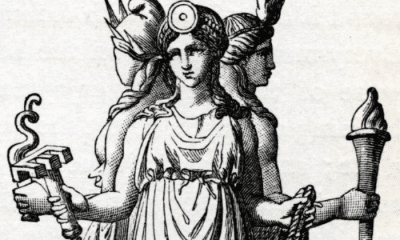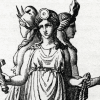Greek
The Story of King Midas in Greek Mythology
King Midas’s golden touch is the classic story of being careful what you wish for. How much do you really know about the legendary king of Greek mythology, though?
Although his legend is famous, King Midas was not known in Greek mythology.
Instead, it was Greek historians who mentioned the king of Phrygia and his immense wealth. They saw Midas not as a legendary figure, but as a historical king of a foreign land.
Midas did not become a mythological character until the Roman writer Ovid included him in his Metamorphoses. Ovid’s stories of the golden touch and the king with the ears of a donkey became popular tales with a clear message against greed and rash action.
Did this historical king inspire Ovid’s legends, though? Modern history and archaeology shows that the Roman poet may have had reason to associate the ancient king of Phrygia with the creation of wealth.
King Midas and his Curses
According to Greek legends, Midas was the king of Phrygia, a region of what is now central Turkey.
While many older Greek sources mention Midas, his most famous myth appears in Ovid’s Metamorphoses. This story appears to have largely been an invention of the Roman poet, although it may have been influenced by earlier traditions.
In this story, Dionysus’s foster father, the satyr Silenus, became lost when he was drunk on wine. He was found by Phrygian peasants who took him to their king.
Midas welcomed the elderly satyr as if he were an honored guest. For ten days and nights, King Midas hosted Silenus and stayed up late into the night feasting and playing music with him.
Dionysus had grown worried about his old friend’s absence, but was relieved when Midas safely returned him to the god’s temple in Lydia on the tenth day. To thank him for his hospitality, Dionysus offered the king any boon he wished.
Without hesitation Midas said that he wanted the power to make anything he touched turn to gold. He grew excited at the prospect of endless wealth even as the god of wine cautioned him that it was a foolish request.
Midas tested his power by plucking a twig from a nearby tree. He was delighted when it immediately turned to solid gold.
Returning to Phrygia, Midas excitedly turned everyday objects in his palace to gold. The kingdom’s riches grew, but Midas soon became disillusioned with his new ability.
According to Ovid, Midas saw the downside of his wish when he sat at his dinner table. He could not eat or drink because everything turned to hard gold as soon as it touched his lips.
In a later story, Midas turned the roses in his garden to gold. When his daughter cried that she missed their sweet smell he instinctively embraced her and watched in horror as she turned into a solid golden statue.
Midas soon returned to the temple of Dionysus and begged the god to take away the gift he had so recently asked for. He was told to wash his body and whatever he wished to be restored to its original form in the River Pactolus to remove the curse.
Midas did as he was told and was relieved to see the gold wash away into the sand on the bottom of the river. The river continued to provide wealth as a source of gold, but Midas was freed of his curse.
Ovid continued the story of Midas, saying that the king abandoned all thought of riches after the curse was lifted and retreated into the forest. He sought a simpler life as a follower of Pan.
In a story that echoed the older myth of Marsyas, Pan challenged Apollo to a music contest. Apollo was declared the winner by every judge except Midas.
Midas proclaimed that he thought Pan’s pipes sounded better than the lyre. In a rage, Apollo cursed the foolish former king.
He declared that only an ass could have such horrible taste, and if Midas heard like an ass he should have the ears of one to match. He turned the man’s ears into those of a donkey, humiliating Midas.
For the rest of his life, Midas hid his ears under a large headdress. Only his barber knew the king’s secret, and he was sworn to secrecy on pain of death.
The barber could not keep the secret to himself, however. To relieve himself of it, he dug a hole in a field and whispered the secret of Midas’s ears into it.
The hole betrayed him, however. A thick bed of reeds grew out of it and whispered “King Midas has an ass’s ears,” into the wind.
Midas could not bear to have his secret known to the entire world. To spare himself from further humiliation, he committed suicide by drinking a potion made from bull’s blood.
My Modern Interpretation
While Ovid’s stories of King Midas are fantastic, historians can say with some certainty that the character was based on an historical figure.
Both Greek and Assyrian sources attest to King Midas as a ruler of Phrygia in the 8th century BC. Later sources also mention a Midas, who may have been a descendant of the earlier king or named from him, in the 6th century BC.
One of these kings appears to have had a close relationship with the Greeks. This was probably the later Midas, who donated a throne to the oracle of Delphi.
This Midas also married a Greek woman, Damodice or Hermodike. The stories surrounding her provide one of many explanations for the king’s legendary wealth.
The kingdom of Phrygia was rich in valuable metals. Gold and electrum were mined in the area and one Greek historian claimed that Midas himself had discovered black and white lead.
The mineral resources of Phrygia could be at the root of Midas’s legendary wealth. His wife’s contributions to history further cemented the king’s association with gold.
According to Greek writers, Damodice had invented the first coinage. Although it is more likely that she introduced Near Eastern monetary systems to the Greeks, she still revolutionized the Greek economy.
The first coins were too large to be used by most people in daily life. Instead, they were used for large purchases and for the payment and accounting of taxes.
While common people continued to rely on a barter system in private life, the government kept accounts by a metal standard. By accepting taxes and payments in modern coins instead of goods like grain and livestock, the view of metal became the measure of Phrygian wealth.
This may have been the origin of Midas’s golden touch. While the new accounting system of the Phrygian kings represented their wealth, it was not in a form that could be eaten.
The story of the king’s golden touch is likely rooted in the wealth of Phrygia. The continued tale of Midas’s ears, however, comes from a different source.
While some historians believe that horse ears may have been part of a ceremonial crown in the Near East, others have noted the similarities between the story of Midas and legends from elsewhere in Europe.
Ovid likely took the music contest in Midas’s story directly from earlier Greek stories of Marsyas. The king’s punishment, however, seems to be part of a broader motif.
Central Asia, Ireland, and Brittany all had stories of kings who were given the ears of a donkey or horse as a punishment from the gods. In each of these legends, the secret was known only to the king’s barber.
In each story, the barber whispers the secret to a plant or well but it is revealed through the sounds made by those plants or something made from them.
It is almost certain that these stories were taken not from an ancient archetype, but directly from the same source. The similarities are too strong to be coincidental.
Ovid may have been the inspiration for the versions told in both Celtic Europe and Asia, but it is possible that he was inspired by a similar story himself. The comedic image of the king with ass’s ears has been noted by many to not seem to fit well into Greco-Roman conventions.
The king’s fate appears to be another element of the legend that was inspired by history. According to Greek sources, the first King Midas of Phrygia killed himself by drinking bull’s blood when his city was under attack.
Archaeologists have found evidence showing that Gordium, the ancient capital of Phrygia, was sacked sometime between 700 and 675 BC, the same range of time given by ancient historians for the death of Midas.
In Summary
King Midas is attested as an historical figure in both Greek and Assyrian sources. At least two major kings by that name ruled the kingdom of Phrygia in Central Turkey, one in the 8th century BC and the other in the 6th century BC.
He became a legendary figure in the early Roman Empire when Ovid included two stories about him in the Metamorphoses.
The first is the classic cautionary tale warning against impulsive wishes. When Midas asks for everything he touches to be turned to gold, he quickly asks for the gift to be taken away when even the food he tries to eat is transformed.
Historians believe that this story is rooted in the association between Phrygia and valuable mineral deposits. Gold, electrum, and lead were all mined in Phrygia, making it a wealthy kingdom.
The 6th century Midas was also said to have married a Greek woman who introduced the concept of coinage as a standard for taxation. The metal-based wealth of the Phrygian government made it more prosperous, but it was also in a form that could not be used or enjoyed for its own sake.
The second legend of Midas is one in which he is given the ears of a donkey for claiming that Pan was a better musician than Dionysus. While unusual in Greco-Roman mythology, the scene is almost directly echoed in stories from several later cultures.
While the legends of King Midas are fantastic, they are rooted in historical truths. Ovid created the well-known stories of the Phrygian king, but like many myths his poems contained traces of facts that can be proven by historians and archaeologists.



